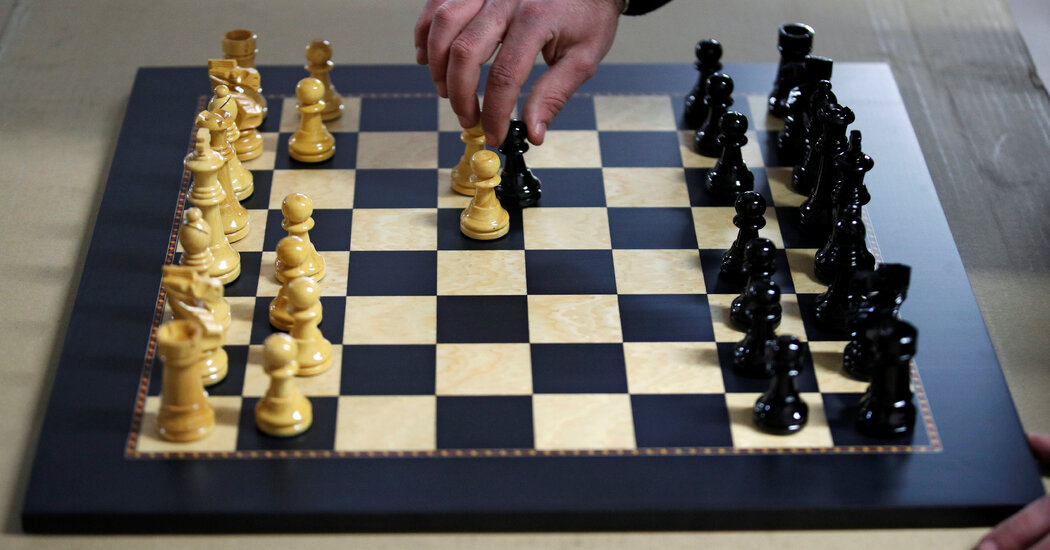
After more than two years of play, Jon Edwards, a retired administrator at Princeton University, won the 32nd World Correspondence Chess Championship on tie-breaks last month, beating correspondence chess grandmasters from around the world. Mr. Edwards, who earned his own correspondence chess grandmaster title in the process of winning the championship, is the first American to triumph in the event in nearly 40 years, and only the third American ever to do so.
While many chess professionals worry that their opponents — in person or online — will cheat by using chess engines, or software that determines the best move, correspondence players have embraced their use. The International Correspondence Chess Federation allows players to consult engines during their games, making the matches a hybrid competition that involves the strategy and planning of humans guided by the accuracy of machines. In correspondence chess, players may spend days or even weeks on a single move. A typical game can last for more than a year.
What does it mean to be the best in the world at a game in which a player’s strength is enhanced — or neutralized — by computers? When asked about his own approach, Mr. Edwards said that his style was similar to that of Tigran Petrosian, the Armenian grandmaster known for his fortresslike defensive play. In most of Mr. Edwards’s games, he tries to create and press a small advantage with the goal of gently nudging his opponents over the edge where, even with the help of the strongest engine, they are unable to escape an inevitable defeat.
Even with such a plan, a majority of correspondence games end in a draw because it is nearly impossible to beat an opponent who has access to the defensive resources of a chess engine. Out of the 136 games played in the 32nd World Correspondence Chess Championship, 119 were draws. What’s more, when games are decisive, this is sometimes because of human error.
Given the high number of draws and the difficulty of winning even a single game, could Mr. Edwards be the last world champion correspondence player? He didn’t seem to think so. “Most outsiders and many players believe that correspondence chess is dying,” he said, “but the best correspondence players don’t believe that.”
Alex King, a FIDE master who recently played in his first I.C.C.F. event, said that, despite the more level playing field of correspondence chess compared to typical games, he still enjoyed himself. “Just the purely aesthetic aspect of playing chess — I still get a kick out of that even when other elements are removed,” Mr. King said.
Correspondence chess helps shape chess at the highest level. Because of the mechanized nature of the process, many correspondence players find themselves treading into previously unexplored territory. Mr. Edwards said that he would sometimes share his new discoveries with the coaching team of elite players to help them find new tools to spring on unsuspecting opponents.
Historically, correspondence chess has been a contemplative diversion for intellectuals, aristocrats and soldiers. The earliest correspondence games for which a surviving record exists took place in 1804, between Friedrich Wilhelm von Mauvillon, a Dutch army officer stationed in The Hague, and a compatriot of his who was stationed in Breda, the Netherlands. Mauvillon published three of these games in a chess book in 1827, forever immortalizing his draw and two victories over his friend.
Looking back even further, it is believed that King Henry I of England, whose reign lasted from 1100 to 1135 A.D., played correspondence chess with his counterpart in France, King Louis VI, who reigned from 1108 until 1137. The French enlightenment writer and luminary Voltaire is noted to have played correspondence chess with his pupil Frederick the Great of Prussia. Their moves were securely escorted by royal courier between Berlin and Paris. It’s also thought that Venetian merchants played correspondence chess with one another, contemplating their next moves on voyages between ports.
Even in the past, correspondence chess was a vehicle for innovation. Take, for example, the French Defense, an opening that is played at all levels of chess in the modern era. In the 1830s, a London chess club played a correspondence match against a Parisian club. The English players, playing with the white pieces, began with a standard move — 1 e4, moving their pawn forward two squares. The Parisian players countered with e6, which was unusual at the time, moving their pawn forward only one square. Thereafter, the opening was called the French Defense.
The advent of telegraphic cables and morse code facilitated near instantaneous communication of chess moves across long distances, allowing for matches between the best players in the world to be played without the burdensome and expensive task of long distance travel. One famous example was the Capablanca Memorial tournament that took place in Havana in 1965. Unable to travel to the event because of the American embargo of Cuba, Bobby Fischer played via teletype.
Today, computers play a central role in elite correspondence events not only by instantly relaying a move, but also by helping players determine the move they should play. Despite this, or perhaps because of it, correspondence chess still holds an interest for amateurs and professionals alike and will probably continue to for years to come.
Now that the World Correspondence Chess Championship is finally over, I asked Mr. Edwards if he intended to defend his title. “I received word that I had won on Saturday, Oct. 8,” he said. “Two days later they invited me to accept the final spot in the 33rd world final. I declined because I truly need a break.”